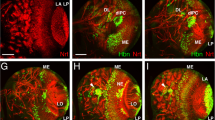Abstract
MURINEHox genes have been postulated to play a role in patterning of the embryonic body plan1–3. Gene disruption studies have suggested that for a given Hox complex, patterning of cell identity along the antero–posterior axis is directed by the more 'posterior' (having a more posterior rostral boundary of expression) Hox proteins expressed in a given cell4–6. This supports the 'posterior prevalence' model2, which also predicts that ectopic expression of a given Hox gene would result in altered structure only in regions anterior to its normal domain of expression. To test this model further, we have expressed the Hox-4.2 gene more rostrally than its normal mesoderm anterior boundary of expression, which is at the level of the first cervical somites. This ectopic expression results in a homeotic transformation of the occipital bones towards a more posterior phenotype into structures that resemble cervical vertebrae, whereas it has no effect in regions that normally express Hox-4.2. These results are similar to the homeotic posteriorization phenomenon generated in Drosophila by ectopic expression of genes of the homeotic complex HOM-C (refs 7–10; reviewed in ref. 3).
Similar content being viewed by others
References
Gruss, P. & Kessel, M. Curr. Opin. Genet. Dev. 1, 204–210 (1991).
Duboule, D. Curr. Opin. Gene. Dev. 1, 211–216 (1991).
McGinnis, W. & Krumlauf, R. Cell 68, 283–302 (1992).
Chisaka, O. & Capecchi, M. Nature 350, 473–479 (1991).
Lufkin, T., Dierich, A., LeMeur, M., Mark, M. & Chambon, P. Cell 66, 1105–1119 (1991).
Chisaka, O., Musci, T. S. & Capecchi, M. Nature 355, 516–520 (1992).
Schneuwly, S., Klemenz, R. & Gehring, W. J. Nature 325, 816–818 (1987).
Kuriora, M. A. & McGinnis, W. Cell 55, 477–485 (1988).
Mann, R. S. & Hogness, D. S. Cell 60, 597–610 (1990).
Gonzàlez-Reyes, A. & Morata, G. Cell 61, 515–522 (1990).
Verbout, A. J. Adv. Anat. Embryol. Cell Biol. 90, 1–122 (1985).
Theiler, K. Adv. Anat. Embryol. Cell Biol. 112, 1–99 (1988).
Remak, R. Untersuchungen über die Entwicklung der Wirbeltiere (Reimer, Berlin, 1855).
Bagnall, K. M., Higgins, S. J. & Sanders, E. J. Development 103, 69–85 (1988).
DeBeer, G. in The Development of the Vertebrate Skull (Oxford Univ. Press, London, 1971).
Noden, D. M. Development 103, (suppl.) 121–140 (1988).
Evans, F. G. Ann. N.Y. Acad. Sci. 39, 29–104 (1939).
Lewis, E. B. Nature 276, 565–570 (1978).
Balling, R., Mutter, G., Gruss, P. & Kessel, M. Cell 58, 337–347 (1989).
Kessel, M., Balling, R. & Gruss, P. Cell 61, 301–308 (1990).
Kessel, M. & Gruss, P. Cell 67, 89–104 (1991).
Piveteau, J. in Traité de Zoologie Vol. 12 (ed. Grassé, P. P.) (Masson et Cie, Paris, 1954).
Lathe, R., Vilotte, J. L. & Clark, A. J. Gene 57, 193–201 (1987).
Green, S., Isserman, I. & Scheer, E. Nucleic Acids Res. 16, 369 (1988).
Featherstone, M. S., Baron, A., Gaunt, S. J., Mattei, M. G. & Duboule, D. Proc natn. Acad. Sci. U.S.A. 85, 4760–4764 (1988).
Hogan, B., Constantini, F. & Lacy, E. Manipulating the Mouse Embryo. A Laboratory manual (Cold Spring Harbour Laboratory Press, New York, 1986).
Wasylyk, C. & Wasylyk, B. EMBO J. 5, 553–560 (1986).
Zenke, M. et al. EMBO J. 5, 387–397 (1986).
Dollé, P. & Duboule, D. EMBO J. 8, 1507–1515 (1989).
Ferguson, M. W. J. J. Anat. 125, 555–577 (1978).
Jenkins, F. A. Anat. Rec. 164, 173–184 (1969).
Author information
Authors and Affiliations
Rights and permissions
About this article
Cite this article
Lufkin, T., Mark, M., Hart, C. et al. Homeotic transformation of the occipital bones of the skull by ectopic expression of a homeobox gene. Nature 359, 835–841 (1992). https://doi.org/10.1038/359835a0
Received:
Accepted:
Issue Date:
DOI: https://doi.org/10.1038/359835a0
- Springer Nature Limited
This article is cited by
-
Chiari malformation and atlantoaxial instability: problems of co-existence
Child's Nervous System (2019)
-
Hox genes, evo-devo, and the case of the ftz gene
Chromosoma (2016)
-
Evolution of the vertebrate skeleton: morphology, embryology, and development
Zoological Letters (2015)





